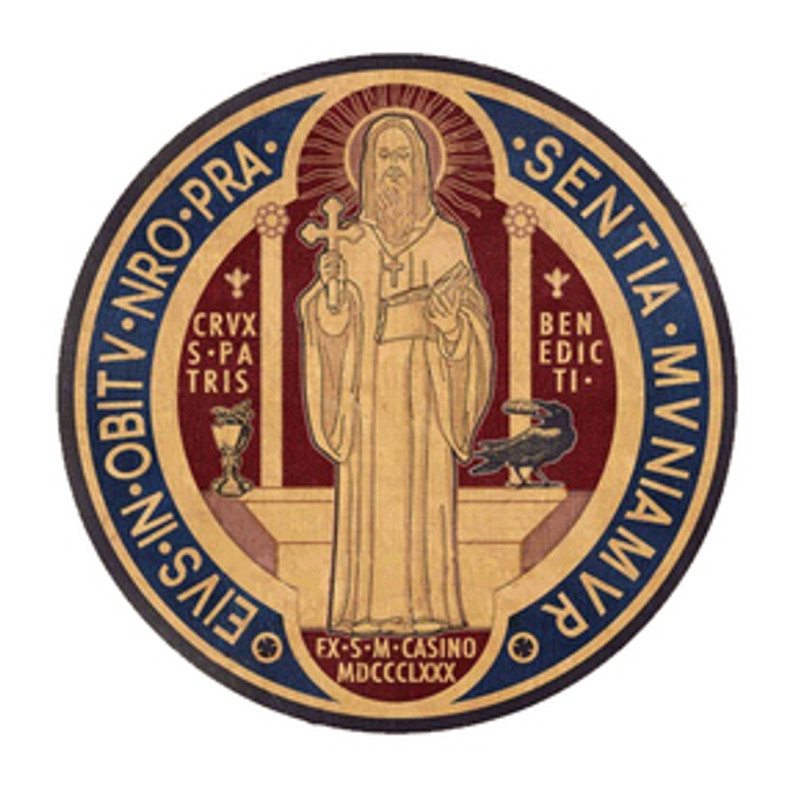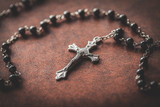St Benedict Medal Story & Symbolism
Origin of the Medal of Saint Benedict / From the HouseTops feature story of the Life of Saint Benedict
For the early Christians, the cross was a favorite symbol and badge of their faith in Christ. From the writings of St. Gregory the Great (540-604), we know that St. Benedict had a deep faith in the Cross and worked miracles with the sign of the cross. This faith in, and special devotion to, the Cross was passed on to succeeding generations of Benedictines.
Devotion to the Cross of Christ also gave rise to the striking of medals that bore the image of St. Benedict holding a cross aloft in his right hand and his Rule for Monasteries in the other hand. Thus, the Cross has always been closely associated with the Medal of St. Benedict, which is often referred to as the Medal-Cross of St. Benedict.In the course of time, other additions were made, such as the Latin petition on the margin of the medal, asking that by St. Benedict's presence we may be strengthened in the hour of death, as will be explained later.
We do not know just when the first medal of St. Benedict was struck. At some point in history a series of capital letters was placed around the large figure of the cross on the reverse side of the medal. For a long time the meaning of these letters was unknown, but in 1647 a manuscript dating back to 1415 was found at the Abbey of Metten in Bavaria, giving an explanation of the letters. They are the initial letters of a Latin prayer of exorcism against Satan, as will be explained below.
The Jubilee Medal of Montecassino
The above features were finally incorporated in a newly designed medal struck in 1880 under the supervision of the monks of Montecassino, Italy, to mark the 1400th anniversary of the birth of St. Benedict. The design of this medal was produced at St. Martin's Archabbey, Beuron, Germany, at the request of the prior of Montecassino, Very Rev. Boniface Krug OSB (1838-1909). Prior Boniface was a native of Baltimore and originally a monk of St. Vincent Archabbey, Latrobe, Pennsylvania, until he was chosen to become prior and latter archabbot of Montecassino.
Since that time, the Jubilee Medal of 1880 has proven to be more popular throughout the Christian world than any other medal ever struck to honor St. Benedict.
Description of the Jubilee Medal
Because the Jubilee Medal of 1880 has all the important features ever associated with the Medal of St. Benedict, the following description of this medal can serve to make clear the nature and intent of any medal of St. Benedict, no matter what shape or design it may legitimately have.
Face of the medal is the image of Saint Benedict. In his right hand he holds the cross, the Christian's symbol of salvation. The cross reminds us of the zealous work of evangelizing and civilizing England and Europe carried out mainly by the Benedictine monks and nuns, especially for the sixth to the ninth/tenth centuries.
Rule and Raven
In St. Benedict's left hand is his Rule for Monasteries that could well be summed up in the words of the Prolog exhorting us to "walk in God's ways, with the Gospel as our guide."
On a pedestal to the right of St. Benedict is the poisoned cup, shattered when he made the sign of the cross over it. On a pedestal to the left is a raven about to carry away a loaf of poisoned bread that a jealous enemy had sent to St. Benedict.
C. S. P. B.
Above the cup and the raven are the Latin words: Crux s. patris Benedicti (The Cross of our holy father Benedict). On the margin of the medal, encircling the figure of Benedict, are the Latin words: Eius in obitu nostro praesentia muniamur! (May we be strengthened by his presence in the hour of our death!). Benedictines have always regarded St. Benedict as a special patron of a happy death. He himself died in the chapel at Montecassino while standing with his arms raised up to heaven, supported by the brothers of the monastery, shortly after St. Benedict had received Holy Communion.
Monte Cassino
Below Benedict we read: ex SM Casino MDCCCLXXX (from holy Monte Cassino, 1880). This is the medal struck to commemorate the 1400th anniversary of the birth of Saint Benedict.
Back of the medal, the cross is dominant. On the arms of the cross are the initial letters of a rhythmic Latin prayer: Crux sacra sit mihi lux! Nunquam draco sit mihi dux! (May the holy cross be my light! May the dragon never be my guide!).
In the angles of the cross, the letters C S P B stand for Crux Sancti Patris Benedicti (The cross of our holy father Benedict).
Peace
Above the cross is the word pax (peace), that has been a Benedictine motto for centuries. Around the margin of the back of the medal, the lettersV R S N S M V - S M Q L I V B are the initial letters, as mentioned above, of a Latin prayer of exorcism against Satan: Vade retro Satana! Nunquam suade mihi vana! Sunt mala quae libas. Ipse venena bibas! (Begone Satan! Never tempt me with your vanities! What you offer me is evil. Drink the poison yourself!)
Use of the Medal
There is no special way prescribed for carrying or wearing the Medal of St. Benedict. It can be worn on a chain around the neck, attached to one's rosary, kept in one's pocket or purse, or placed in one's car or home. The medal is often put into the foundations of houses and building, on the walls of barns and sheds, or in one's place of business.
The purpose of using the medal in any of the above ways is to call down God's blessing and protection upon us, wherever we are, and upon our homes and possessions, especially through the intercession of St. Benedict. By the conscious and devout use of the medal, it becomes, as it were, a constant silent prayer and reminder to us of our dignity as followers of Christ.
The medal is a prayer of exorcism against Satan, a prayer for strength in time of temptation, a prayer for peace among ourselves and among the nations of the world, a prayer that the Cross of Christ be our light and guide, a prayer of firm rejection of all that is evil, a prayer of petition that we may with Christian courage "walk in God's ways, with the Gospel as our guide," as St. Benedict urges us.
A profitable spiritual experience can be ours if we but take the time to study the array of inscriptions and representations found on the two sides of the medal. The lessons found there can be pondered over and over to bring true peace of mind and heart into our lives as we struggle to overcome the weaknesses of our human nature and realize that our human condition is not perfect, but that with the help of God and the intercession of the saints our condition can become better.
The Medal of St. Benedict can serve as a constant reminder of the need for us to take up our cross daily and "follow the true King, Christ our Lord," and thus learn "to share in his heavenly kingdom," as St. Benedict urges us in the Prolog of his Rule.
Two Special Uses of the Medal
By a rescript of the Sacred Congregation of Religious (4 May 1965) lay Oblates of St. Benedict are permitted to wear the Medal of St. Benedict instead of the small black cloth scapular formerly worn.
By a decree of the Sacred Congregation of Rites (6 March 1959), the Blessing of St. Maur over the sick is permitted to be given with a Medal of St. Benedict instead of with a relic of the True Cross, since the latter is difficult to obtain.
(from the Order of Saint Benedict)
Recent Posts
-
Christmas Shop Hours
Warmest wishes for a blessed and Merry Christmas from True Devotionals Shop! Thank you sincerely fo …Dec 20th 2025 -
What is Blessed Salt?
How is blessed Salt Used? Used non-superstitiously, modest amounts of salt may be sprinkled in one’s …Jul 2nd 2025 -
What are Sacramentals?
Sacramentals “are sacred signs which bear a resemblance to the sacraments. They signify effects, par …Jul 2nd 2025





